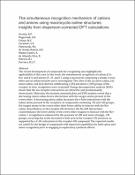Options
The simultaneous recognition mechanism of cations and anions using macrocyclic-iodine structures: insights from dispersion-corrected DFT calculations
Fecha de emisión
2020-11-07
Autor(es)
Pereira Orenha, Renato
Nagurniak, Glaucio R.
Cachoeira Colaço, Matheus
Finoto Caramori, Giovanni
Jeomar Piotrowski, Maurício
de Araújo Batista, Krys Elly
Muñoz-Castro, Alvaro
de Almeida Silva, Breno
Esteves, Benjamim José
Parreira, R. L.T.
DOI
10.1039/d0cp04291a
Resumen
The recent development of compounds for recognizing ions highlights the applicability of this area. In this work, the simultaneous recognition of cations (Li+, Na+ and K+) and anions (F-, Cl- and I-) using a macrocycle comprising a simple crown ether and an iodine-triazole unit is investigated. The roles of the (i) cation radius, (ii) anion radius, and (iii) electron withdrawing (-CN) and donor (-OH) groups of the receptor in ionic recognition were evaluated. Energy decomposition analysis (EDA) shows that the ion-receptor interactions are attractive and predominantly electrostatic. Molecular electrostatic potential plots and EDA analysis reveal that a decreasing cation radius favors interactions with the oxygen atoms present in the crown ether. A decreasing anion radius increases the σ-hole interactions with the iodine atoms present in the receptors. In compounds containing -CN and -OH groups, the oxygen atoms in the crown ether show lower ability to interact with the Na+ cation. Nevertheless, in the receptor-OH structure, the Na+OH interactions counterbalance the lower ability of the crown ether oxygens to interact with the Na+ cation. I- recognition is enhanced by the presence of -OH and, more strongly, -CN groups, occurring due to the increased σ-hole area in the receptor-CN structure, as supported by a C-HI- interaction in the receptor-OH compound. The reported results are useful for the design of compounds with improved capabilities for both cation and anion recognition prior to engaging in exploratory synthesis efforts.
Archivo(s)
Loading...
Name
ThesimultaneousrecognitionmechanismofcationsandanionsusingmacrocycliciodinestructuresinsightsfromdispersioncorrectedDFTcalculations.pdf
Size
36.72 KB
Format
Checksum